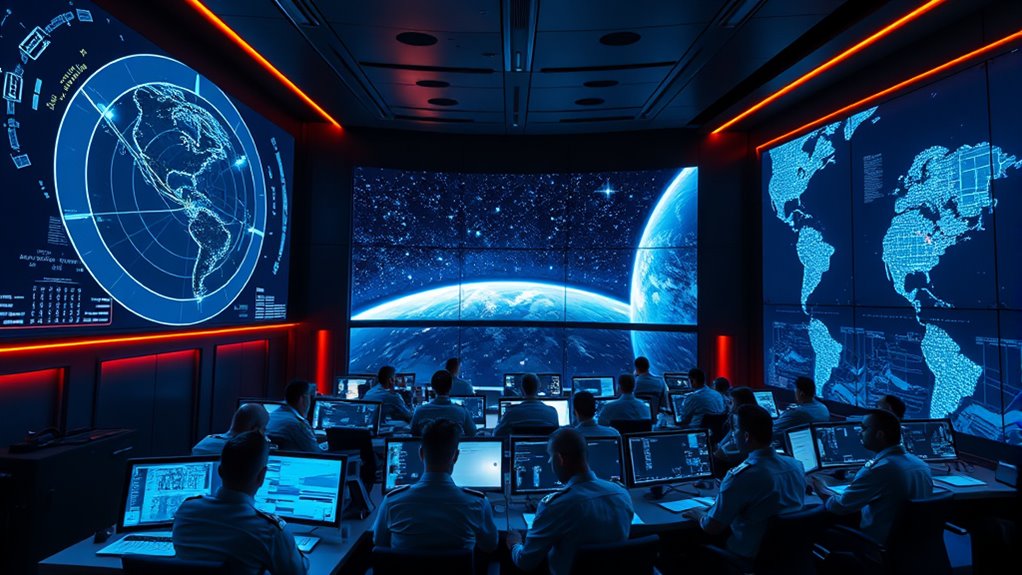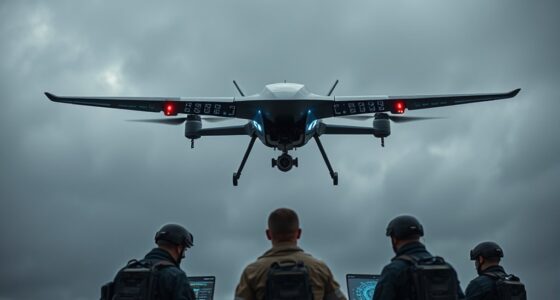The U.S. Space Force enhances your security by deploying advanced satellite surveillance that tracks threats like missile launches and hostile activity. It also protects space-based assets from cyberattacks, ensuring communication and navigation remain intact. Through continuous innovation, Space Force stays ahead of adversaries by monitoring space and responding quickly to emerging threats. If you want to understand how they combine these tools for full-spectrum defense, there’s much more to uncover below.
Key Takeaways
- The Space Force develops advanced surveillance satellites to monitor threats like missile launches and hostile activity in orbit.
- It enhances space domain awareness through real-time data, high-resolution imaging, and signal interception for strategic advantage.
- Space Force prioritizes cybersecurity to protect satellites, communication systems, and data relays from hacking and operational disruptions.
- It employs cutting-edge defense technologies, including encryption and rapid response teams, to counter evolving space threats.
- The branch aims to ensure space dominance by integrating surveillance and cybersecurity for comprehensive national security protection.

Have you ever wondered how the United States monitors threats and gathers essential information from space? The answer lies in the advanced capabilities of satellite surveillance, a fundamental component of modern military intelligence. The Space Force has prioritized developing and deploying sophisticated satellites that can track everything from missile launches to hostile activity in orbit. These satellites serve as an eye in the sky, providing real-time data that helps protect national security interests. With their ability to capture high-resolution images and intercept signals, satellite surveillance offers a strategic advantage in identifying potential threats before they materialize. This technology is constantly evolving to stay ahead of adversaries who also leverage space for military purposes.
Satellite surveillance provides real-time, high-resolution data to protect national security from space-based threats.
But satellite surveillance isn’t just about watching for physical threats. It also plays a pivotal role in monitoring cybersecurity threats that originate or transit through space. As more assets move into orbit—such as communication satellites, GPS systems, and data relays—cybersecurity threats become an increasing concern. Malicious actors may attempt to hack or disrupt these satellites, risking everything from communication breakdowns to compromised military operations. The Space Force works tirelessly to defend these indispensable assets from cyberattacks, employing advanced cybersecurity measures to detect and neutralize threats before they cause harm. In this digital battleground, understanding how cyber adversaries operate and implementing layered security protocols are essential to maintaining space domain integrity.
Your national security depends heavily on the ability to secure these space-based systems. The Space Force’s focus on satellite surveillance and cybersecurity threats underscores a broader shift toward viewing space as a critical domain of warfare. It’s no longer enough to simply have advanced satellites; you need the expertise and technology to protect them from evolving threats. The branch invests heavily in innovations like cyber defense tools, encryption, and rapid response teams that can counteract cyber intrusions in real time. This dual approach ensures that space assets remain resilient, supporting the broader mission of safeguarding the nation.
In essence, satellite surveillance combined with vigilant cybersecurity measures creates a formidable shield around your country’s interests in space. As threats grow more sophisticated, so does the Space Force’s ability to detect, analyze, and respond swiftly. This ongoing effort is essential for maintaining space dominance and ensuring that adversaries don’t gain the upper hand. Whether monitoring missile launches or defending against cyberattacks, the Space Force’s commitment to securing space ensures that you remain protected from threats both seen and unseen, right from the final frontier.
Frequently Asked Questions
How Does Space Force Intelligence Coordinate With NASA?
You coordinate with NASA by sharing satellite communication data and space weather forecasts to guarantee both agencies stay informed and prepared. Space Force Intelligence monitors space weather that could disrupt satellite operations, while NASA relies on this info for safe space missions. Together, you collaborate on tracking space debris, enhancing satellite security, and maintaining reliable communication channels, ensuring the safety and success of space activities for national security and scientific exploration.
What Are the Main Threats Monitored by Space Force Intelligence?
Imagine a vigilant guardian watching over our cosmic backyard. You’re monitoring threats like satellite cybersecurity breaches and asteroid tracking, ensuring space assets stay secure. These threats can disrupt communications, navigation, or even pose an impact risk. Space Force Intelligence actively tracks and assesses these dangers, employing advanced technology to safeguard national security and space operations. Staying ahead of these hazards is vital for protecting both your interests and the future of space exploration.
How Is Data Security Maintained in Space Intelligence Operations?
You guarantee data security in space intelligence operations by using strong encryption protocols to protect sensitive information from unauthorized access. Regularly updating these protocols keeps your data secure against evolving threats. You also prioritize data integrity, verifying that information remains accurate and unaltered during transmission. This combination of encryption and integrity checks helps maintain the confidentiality, authenticity, and reliability of essential space intelligence data.
What Equipment Is Used for Space Surveillance and Reconnaissance?
Imagine your eyes scanning the cosmos—space surveillance and reconnaissance rely on advanced satellite sensors that detect, track, and analyze objects orbiting Earth. These sensors capture essential data and relay it to ground stations, which act like command centers, processing and interpreting the information. Together, they form a high-tech web, ensuring you stay aware of space activities, much like a vigilant guardian watching over the final frontier.
How Does Space Force Intelligence Plan to Develop Future Technologies?
You can expect Space Force Intelligence to focus on satellite development and space weather monitoring to develop future technologies. They plan to invest in advanced satellites that can detect threats early and provide real-time data. By studying space weather, they’ll better understand how solar activity impacts satellites and communications. This proactive approach helps them stay ahead, ensuring national security and operational superiority in the final frontier.
Conclusion
As you watch the Space Force Intelligence take shape, you’re witnessing a new frontier in national security—like charting unknown stars. With its eyes set on the final frontier, it’s clear this branch is ready to navigate the cosmic battlefield. As the universe expands, so does your nation’s ability to stay ahead of threats beyond Earth’s atmosphere. The future of military intelligence is soaring high, and you’re right there, watching it unfold like an epic cosmic voyage.








